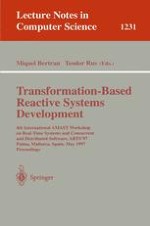1997 | Buch
Transformation-Based Reactive Systems Development
4th International AMAST Workshop on Real-Time Systems and Concurrent and Distributed Software, ARTS'97 Palma, Mallorca, Spain, May 21–23, 1997 Proceedings
herausgegeben von: Miquel Bertran, Teodor Rus
Verlag: Springer Berlin Heidelberg
Buchreihe : Lecture Notes in Computer Science
Enthalten in: Professional Book Archive
